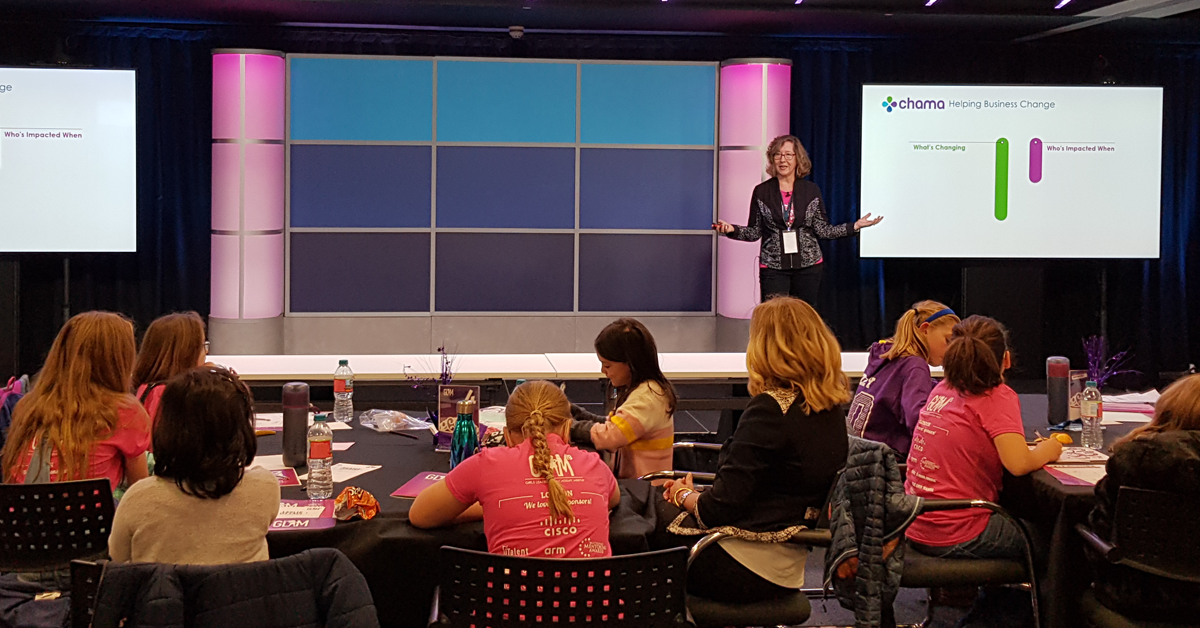
After delivering the presentation to a group of more than 40 girls, I was delighted at how well they understood the concept of managing change. Perhaps more unexpectedly, this exercise of forcing myself to explain DX in such simple terms has helped me explain it better to adults, too! Sometimes, we change leaders use so much industry jargon that even our peers have trouble following us! In this article, I outline how I went about explaining digital transformation and change management to a group of middle school-aged girls.
What does digital mean?
Traditionally, digital means the use of numbers, and the term comes from digit, or finger. Today, digital is synonymous with computers and relates to the 0s and 1s of digital data – the language of computers.
It was great to engage with the girls by asking the question and gaining feedback. Almost all their answers centered around computers, and they were entertained by the traditional meaning.
What does transformation mean?
The process of completely changing the character or appearance of something in order to improve it. The girls immediately guessed what symbolized transformation in nature: the butterfly.
Bringing it all together
Now that they had the concept of digital and transformation, it was easy to get to a simple definition of digital transformation. Digital transformation means transforming an organization’s core business to better meet customer needs by leveraging technology and data.
Drawing on how digital transformation impacts their classroom brought them along another step towards what it means in business. For example:
-
• The use of augmented reality or virtual reality to help students engage from a 3D perspective.
• AI and big data in the classroom leveraged to have one teacher working with all the students and with 1,000 teaching assistants. The students use technology to interact with the teaching assistants to get things answered for them as they are doing their work.
• Personalized learning tools can help students who may be having challenges with reading or writing.
Digital transformation was then put into a business context with two short videos that caught the girls’ attention. One of the videos showed how eBay uses augmented reality to help their sellers choose boxes that fit the item they are shipping. The other video offered a sneak-peek into a Cisco Connected Store, where cameras, sensors and software work together to track inventory, allow shoppers to request a different size without leaving the fitting room, and enable customers to pay for their items with their phone, without standing in line at the cash register.
Now that the concept of digital transformation was understood, the big question was asked: In order to transform a business, what has to change?
Once again, they all guessed it: people.
The example I used to bring change management into the girls’ world was planning for a 3-day weekend with three friends: Kelly, Susan, and Valerie.
Kelly comes up with an idea that she would like to play soccer with her friends Susan and Valerie on Saturday. She reaches out to Susan, who agrees to play soccer, but she would also like to go to the playground on Sunday. Kelly then calls Valerie, who says she’ll play soccer, but she would also like to go to the movies on Monday. So, the girls have collaborated together to come up with all the activities they want to do on the 3-day weekend and on which days. But who have the girls not really thought of in their planning? The girls have some very important people in their lives they are going to impact with all the plans they have made: their parents and their siblings.
Now the girls have to coordinate with their parents and siblings on the plans they envision for the weekend. The parents and siblings have plans they want to do also, and those plans need to be considered. As it turns out, the girls cannot play together on Saturday or Monday because their families have other plans for them. So, the girls decide to pack it all into Sunday by playing soccer in the morning, visiting the playground in the afternoon, and going to the movies that evening. It took a lot of planning and the girls had to talk to everyone involved to be able to know what everyone had planned and when they wanted to do it.
Click here to watch a 6-minute video clip from the event with the 3-day weekend example.
The girls learned that in their world and in business, you need to understand what is changing and who is impacted before you can put together plans to help everyone adapt and adopt for what is coming.
It was a great honor to present to the girls and to support the two-day event hosted by the nonprofit organization, GLAM (Girls Leadership Academy Meetup). Not only was it great fun, but it also reinforced to me the importance of understanding your audience and crafting your message in a way that resonates with them. Oftentimes, I think we get too caught up in business terminology and frameworks and forget to keep things simple and use terms your audience can receive. A good reminder for us all!



